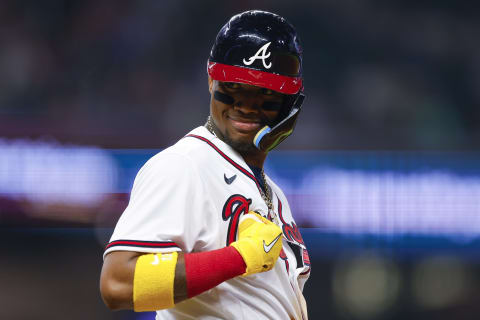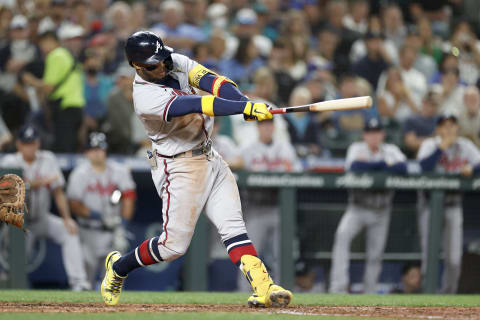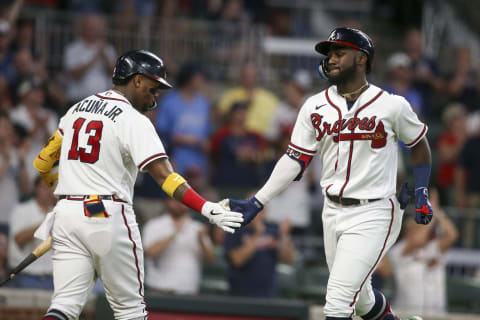Should the Braves swap Ronald Acuña Jr. and Michael Harris II in the lineup?


While it is hard to imagine Ronald Acuña Jr. anywhere in the Braves lineup aside from the leadoff spot, the Braves may want to consider moving him in the lineup, perhaps swapping him with Michael Harris II.
Ronald Acuña Jr. leading off for the Atlanta Braves has become a staple in baseball.
Acuña hitting first for the Braves has bred many iconic moments in baseball over the past few years like his stretch of consecutive games with a lead-off homer, culminating in the Marlins drama, when starter Jose Ureña hit Ronald with a pitch that injured Acuña and forced him to leave the game.
Moments like that and many others have cemented Ronald Acuna Jr. as one of the best lead-off hitters in the league over the past few years, combining his great hitting abilities and speed to produce one of the scariest matchups if you are a starting pitcher making their first few pitches of the game.
Suggesting anyone to lead off for the Braves not named Ronald Acuña Jr. once he returned from his 2021 ACL tear at the beginning of the 2022 season may have seemed insane, but with his offensive production waning since his return to the team in May, a little shake-up in the lineup could be beneficial to everyone.
One Brave who could fill the lead-off slot if the Braves were to ever move away from Ronald hitting first could be rookie of the year candidate Michael Harris II.
Harris, who has been having an incredible rookie season, possesses many of the qualities that make Acuña such an exciting lead-off hitter including blazing speed and the ability to consistently hit for extra bases.
While its unlikely Brian Snitker and the rest of the Braves coaching staff decide to place Harris in the lead-off spot, I have examined the pros and cons to discern whether it is worth swapping the two standout outfielders in the lineup.

Michael Harris has shown he can hit anywhere in the lineup.
Since debuting in Atlanta, Harris has spent most games hitting in the 9th spot in the lineup. However, in the past few months with the additions of Vaughn Grissom, Robbie Grossman, and Eddie Rosario into the lineup, Harris has spent time hitting in the 8th, 7th, 6th, and even 1 game in each of the 2nd spot and leadoff spot.
Excluding his offensive contributions in the 1st and 2nd spot due to the small sample size of 1 game each, Michael Harris has excelled at each of the other spots in the lineup, arguably hitting better in the 8th, 7th, and 6th spot than the 9th spot.
6th spot: .450/.476/.850
7th spot: .313/.333/.656
8th spot: .333/.429/.571
9th spot: .303/.337/.533
He does have a larger sample size in the 9th spot, but the amount of games he has spent in each of those spots is more than enough to show he is more than capable of producing at any part of the lineup he is put in.
Michael Harris is hitting for more extra-base hits
There is no doubt the undeniable advantage of having your lead-off excelling at reaching first base, whether that be from single, walk, HBP, or other means. But the ability to have your lead-off start at second base, third base, or even trotting around the bases is even more valuable.
Though many traditionally think of the lead-off hitter to be a speedy get-on-base kind of guy, many teams have moved away from that philosophy in recent years.
Teams like the Dodgers with Mookie Betts, the Rangers with Marcus Semien, and the Yankees with Aaron Judge have elected to put a capable slugger in their leadoff spot as opposed to their fastest, best on-base guy.
All 3 of those teams are in the top half of the league in percentage of games with a run in the first inning, with the Dodgers being one and the Yankees two on that list. While scoring a run in the first inning often takes more than just the leadoff hitter, they often are the catalyst for the offense that inning and set up the team for success early in the game.
Michael Harris has displayed an incredible ability to hit to all fields for power, which has allowed him to cash in plenty of doubles which gives his team a great opportunity to score given his speed.
Michael Harris – .557 slugging percentage, 24 doubles, 18 home runs, 149 WRC+
Ronald Acuña Jr. – .401 slugging percentage, 20 doubles, 11 home runs, 112 WRC+
In fewer games, Michael Harris has accumulated more extra-base hits than Ronald Acuña. Harris’ ability to slug and extend hits for more than a single has led the Braves to have some of the best offensive production in the league out of the 7th-8th-9th spots in the lineup
Michael Harris II is a slightly better base runner
I considered not including this in the list because there’s not a humongous difference between the two in this category. Ronald Acuña Jr. and Michael Harris II are great base runners, both in the top 20 of the MLB in BsR with Acuña at a BsR of 4.5 compared to Harris’ BsR of 4.7. While that is not a substantial difference, it is worth mentioning, especially considering Harris has played 11 fewer games than Ronald.
Acuña has stolen more bases, with his current total sitting at 27 compared to Harris’ total at 16 which is a large difference. The discrepancy between their BsR totals comes from the number of times Ronald has been caught stealing. Acuña has been caught stealing 10 times on 37 attempts, while Harris has been caught stealing once over 17 attempts.
Acuña has obviously attempted more stolen bases which is why he has been thrown out more, but Harris has a higher successful stolen base percentage regardless. That is important because many metrics have shown it is more detrimental to a team when a player is caught stealing than it is beneficial when they steal a base successfully.
The difference in base running between the two is very minimal, it just comes down to whether you prefer a more aggressive base runner like Ronald as opposed to a safer base runner like Harris, though many stats and metrics do tend to prefer Harris’ safer base running.
Another thing to consider when looking at their base running as Ronald’s recent knee pain which sidelined him for a few games and has left him as a DH since. You can tell he is playing through injury which could affect his speed substantially.
Acuña could benefit from a change of pace
There is no question about the immense amount of pressure a MLB player feels to suit up and perform well in front of 40,000 fans every day. I’m sure that pressure is only increased when you are looked upon to be the catalyst for the offense and lead off the team.
A possible change in where Ronald bats in the lineup could not only spark some production he has been missing this season, but also alleviate some of the pressure I’m sure he is feeling as the everyday lead-off in the lineup.

Ronald Acuña is better at making contact
One of the important functions for a leadoff hitter is to not strikeout and be able to extend an at-bat past the typical amount of pitches seen. Having a pitcher throw 8+ pitches to the lead-off hitter not only fatigues the starter early in the game but could potentially shave off a whole inning off that pitcher’s outing as well.
One of the best examples of this I have seen in 2022 is Mets centerfielder and leadoff hitter Brandon Nimmo, who always seems to make Spencer Strider throw 10+ pitches in his first at-bat.
The key to extending at-bats is being able to identify strikes and be able to foul those off, while not chasing anything out of the zone. Unfortunately for Michael Harris, that is probably the weakest part of his hitting.
Michael Harris’ O-swing % (percentage of pitches a batter swings at that are out of the zone) in 2022 sits at 42.9%. That is a sharp contrast to Ronald’s O-swing %, which sits at a much lower 27.7%.
Their chase rates tell the same story. Harris has a 40% chase rate, while Acuña’s chase rate is only 23.8%.
It is clear Acuña has a better eye and does a better job identifying a ball from a strike, preventing him from chasing pitches at the rate that Harris does.
Michaels Harris’s strikeout rate for the 2022 season sits at 24.5%, which gives him the 54th highest strikeout rate for players with a minimum of 350 plate appearances in the 2022 season. Ronald isn’t much better than that, placing 75th on that list with a strikeout rate of 23.4%.
While the strikeout numbers are pretty similar, those numbers combined with the O-swing % and chase rate illustrate Ronald having a better plate discipline, an important part of a lead-off hitter’s job
Ronald Acuña gets on base/walks more
Most people would agree the most important job for a lead-off hitter is to simply get on base. That is one of the areas this season where Ronald Acuña has done a better job than Michael Harris. When looking simply at their on-base percentages, Acuña’s OBP is slightly higher at .357, 5 points higher than Harris’ OBP which is .352.
Once again not a substantial difference between the two, but still noteworthy when considering walk percentages.
Michael Harris’ 4.5% walk percentage is the 15th lowest walk percentage in the league which is low when you factor that he is one of 2 hitters in the bottom 50 in walk percentage with an OBP above .350 (the other is Andres Gimenez). Ronald’s 10.3% walk percentage slots him in at the 59th highest walk percentage in the league.
There is something invaluable about starting off the game with a walk, which is something that Ronald Acuña is more capable of achieving than Michael Harris.
Michael Harris is significantly worse against a starter the first time he faces them as opposed to the 2nd and 3rd
As a game progresses and the Braves lineup faces the starter for the 2nd and 3rd time, Michael Harris hits significantly better.
2nd inning: .209/.244/.326
4th inning: .300/.400/.333
5h inning: .383/.408.830
9th inning: .407/.429/.926
His first inning stats are very similar to his 2nd inning stats (.570 OPS), but he has had very limited at-bats in the first inning, so the sample size is not there to make an accurate judgment.
Many see this trend amongst his hitting as an indicator that he is just a very clutch hitter. While that is not wrong and he has exemplified he is a very clutch hitter, there might be a better explanation.
Michael Harris finds far more success in his hitting in the 2nd and 3rd time he faces a starter, while his 1st at bat versus a starter sees a significant fall off in production.
1st at-bat against starter: .195/.239/.310
2nd at-bat against starter: .354/.400/.658
3rd at-bat against starter: .357/.438/.643
A player who struggles in his first at-bat versus a starter is not exactly what you want from your leadoff hitter. That is why Ronald Acuña Jr. has been such a successful leadoff hitter these past few years. He is just as good in his third at-bat versus a starter as he is in his first at-bat, if not better than his first at-bat.
1st at-bat against starter: .297/.347/.451
2nd at-bat against starter: .256/.340/.407
3rd at-bat against starter: .233/.325/.370
Acuña is at his best in his first at-bat of the game, which is something you want out of your leadoff hitter.
Acuña supplies more energy
While this point might seem very trivial to many, I personally believe this is what has made the Braves’ offense so exciting in the past few years.
Though many disagree with how Ronald Acuña plays the game, there is no denying he is having fun and playing with high energy. That is apparent in his play style and celebrations after he does something great, which is quite often.
As many who have played baseball before know, the energy and momentum of your teammates does rub off on you. That is why some teams have incredible late-game comebacks. In baseball, it often only takes one hit to get the offense going because energy and momentum are contagious.
Acuña plays with his heart on his shoulder and that definitely translates to his teammates. When he hits a ball into the outfield and stretches a what-should-be-single into a hard-fought double, he is going to jump up in the air and celebrate, and his team will celebrate with him in the dugout.
Not only does that demoralize the pitcher, but it also gives his teammates the confidence to repeat what he just did.
This is not to say that Harris does not play with any sort of energy because he definitely does, but it is extremely hard to match the sort of heart-on-your-shoulder play that Acuña utilizes.

Does it Matter?
There is no definitive answer to this question.
In years past, it would be an easy no. The lead-off job was Ronald’s job and there was no taking it from him, mainly because of his incredible production there.
While he is not doing a bad job by any means in the lead-off spot, many can wonder if you can get more out of Ronald in a different part of the lineup and more out of the lead-off spot if someone like Michael Harris II is there instead.
With less than a month until the start of the playoffs and the remaining regular season becoming more and more important for the Braves with the Mets just a few games ahead in the division race, it will be interesting to see what kind of roster changes or positional/lineup changes are made leading up to October and whether this will be one of them.